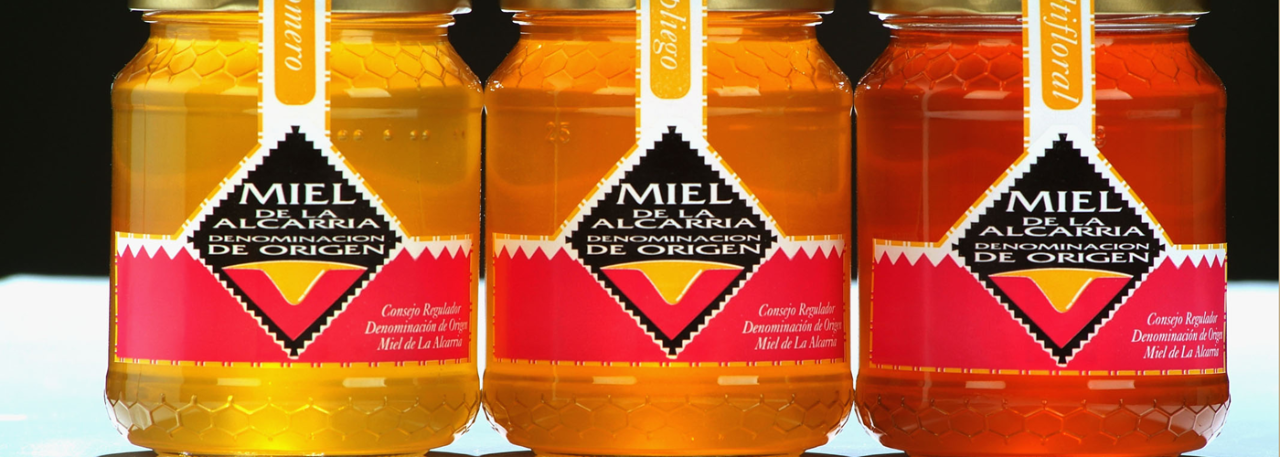.png.transform/rendition-xs/image_image%20(1).png)
Miel de La Alcarria PDO
Honey made by the honey bee from the nectar of flowers or from secretions coming from the living parts of plants or found on them which bees suck, transform, combine with specific substances, store and leave to ripen in honeycomb inside hives located within the designated area.
Tasting notes
- Rosemary honey: very slight aroma, floral, sweet, aniseed-flavored, resinous and with notes of cut grass, mushroom or butter. The flavor is mild, not very persistent and delicate with a slight aftertaste. The color varies from light straw to light, lemony cream.
- Lavender honey: medium to strong aroma, balsamic, fresh, floral and aromatic. The flavor is persistent and refreshing, with a characteristic intense, fruity aftertaste. The light yellow color varies from gold to reddish amber.
Other notes
- Polyfloral honey: the aroma and flavor is a combination of the flavors of the above, therefore it is similar to menthol. The color is also a combination of the colors of the above honeys, and may even be a dark reddish color.
Production / Processing method
The honey comes from registered hives that are preferably of the movable frame type.
Harvesting begins when the honey has reached the right degree of maturity, when the filled frames are lifted out of the super and replaced by empty frames, ensuring that a supply of honey is left in the hive.The bees are removed from the frame, preferably using a blower.The frames removed from the hives are completely capped and free of brood.
The honey is extracted from the frames by uncapping and spinning. Uncapping removes the caps placed by the bees when the honey inside the honeycomb cells is ripe.
The frames are fitted over a tray to collect and drain the caps, which are removed using combs or knives. The honey is also extracted from the uncapped frames using tangential or radial extractors at gradually rising spinning speeds. After extracting the honey, it is filtered to eliminate any fragments of wax, bees and other impurities.
The honey is then decanted to a tub where it is left to stand. The decantation period varies from a few days to one month. During this period, any air bubbles rise to the surface, as do any wax particles or other foreign bodies.
When the honey is clean and ready for sale, it may be either crystallized or liquid. The La Alcarria honey results in fine crystallization, giving honey that is creamy and smooth in the mouth.
The honey may be heated to a maximum of 45ºC for bottling, the aim being to preserve all its therapeutic and nutritional properties. Pasteurization is not allowed, to ensure that the physical, chemical and organoleptic properties are not altered.
The honey is stored and transported in tubs made of food-grade plastic or metal or of stainless steel, or using any other authorized system that will not affect the quality.
Geography / Relief and climate
La Alcarria is located on a high plain at 2,900 to 3,200 ft, with small rivers that have carved out valleys and gorges. The river banks are covered with aromatic plants and bushes.
The altitude above sea-level along the valleys is, 2200 to 2,600 ft. The largest is the Tajuña river valley which divides the district into two.
The area forms a triangle bordered by the valleys of the Henares river to the north and the Tagus to the south, and the foothills of the Sistema Ibérico mountains to the east.
This is an area of moors stretching between the secondary peaks of the Sigüenza plain and the Cuenca range to the north, the Sierra de Altamira to the east, the Tagus and Guadiela rivers to the south, which separate it from the La Mancha plains, and the gentle landscape of the Henares to the west.
The area covered is 4,245 km2, measuring 120 km / 74.5 mi from north to south, and 60 km / 37.28 mi from east to west.
The La Alcarria soils are basic tertiary soils, with marl and limestone. The wild flowers include labiates such as rosemary (Rosmarinus officinalis L.), thyme (Thymus sps), lavender (Lavandula latifolia Medicus), savory (Satureja sps), hyssop (Hissopus officinalis, L.), as well as other plants such as bearberry (Arctostaphyllos uvaursi, L) and genista (Genista scorpius, L), etc.
The climate is temperate-cool Mediterranean. Average temperature is 8-12ºC / 46-53ºF, with long cold periods when temperatures vary from 0 to 4ºC / 32-39ºF, and with long hot periods between 18 and 22º C / 64-71ºF.
Regulatory Council
Consejo Regulador de la DOP Miel de La Alcarria
C/ Camino de San Martín, s/n
19180 Marchamalo (Guadalajara)
Tel: (+34) 949 252 354
Fax: (+34) 949 252 354
consejoregulador@mieldelaalcarria.org
www.mieldelaalcarria.org
Sources:
The honey is extracted from the frames by uncapping and spinning.


- Miel de La Alcarria 1
- Miel de La Alcarria 2

Marchamalo (Castile-La Mancha)
